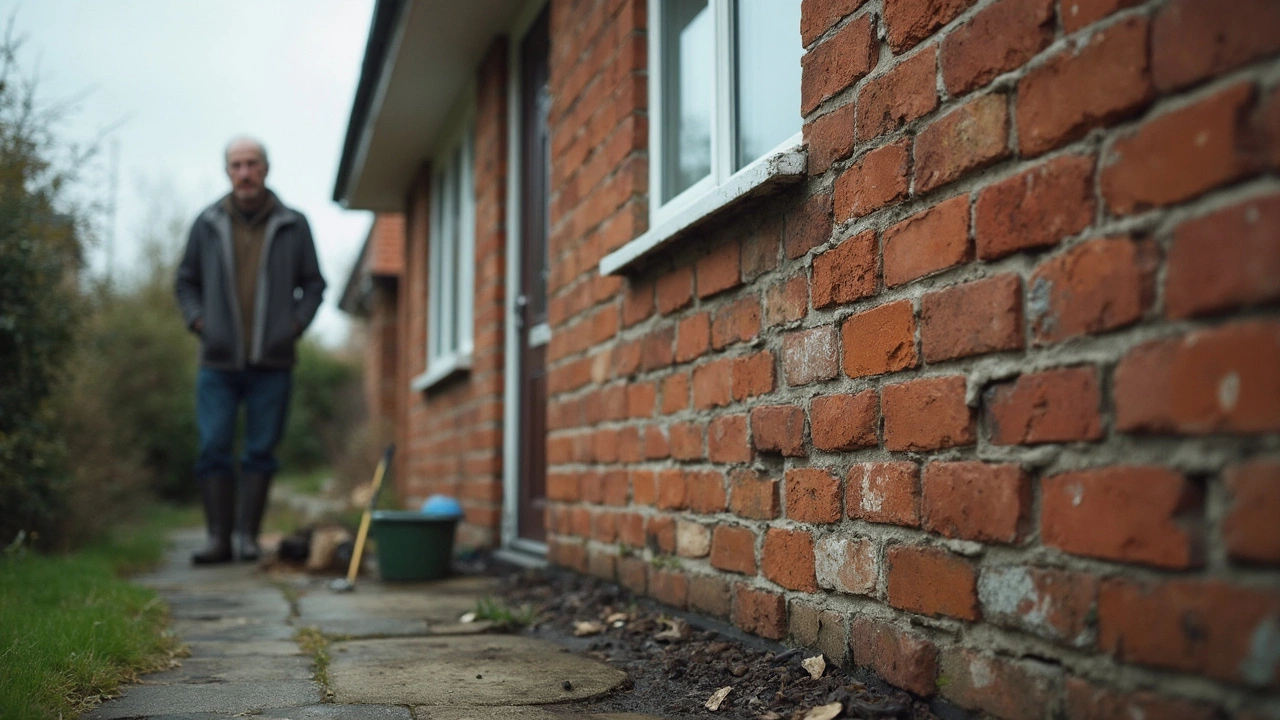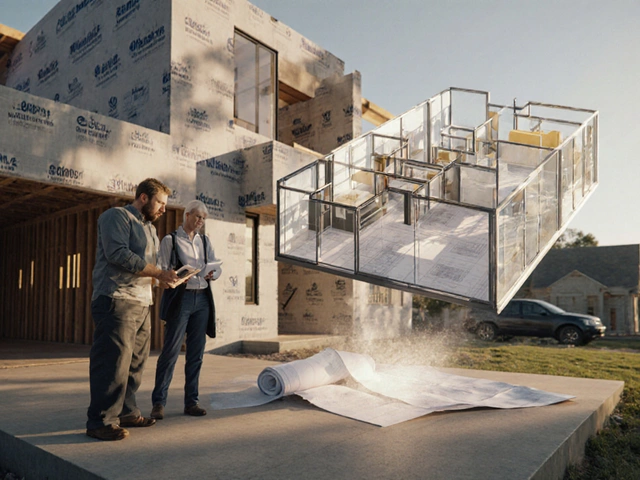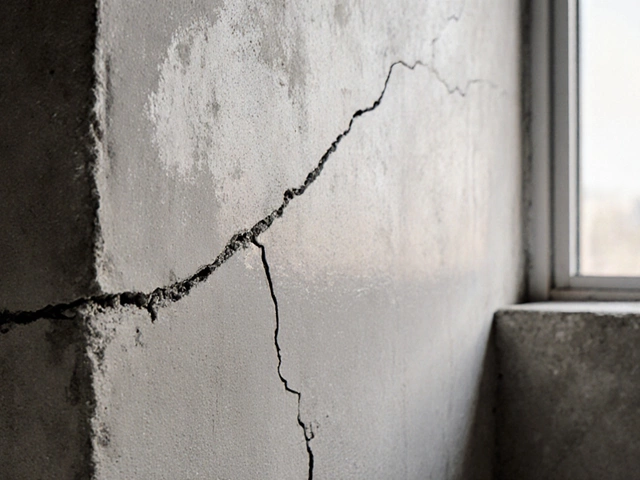Notice cracks creeping up your walls or doors getting stuck? These might be early signs your foundation is sinking. It sounds scary, but it's actually a pretty common headache for homeowners. If you ignore it, though, the fixes just get more expensive. The good news is, you can keep most of the damage in check if you jump on the problem early.
First things first—don't panic. A sinking foundation doesn't mean your house is doomed, but it is something you need to tackle. Most sunken spots are caused by shifting soil, poor drainage, or just the way your house settles over time. Fixing the root cause beats patching up the same cracks again and again.
Before you break out the jackhammer or call every contractor in town, it pays to understand what's going on under your floors. A little know-how now can save you loads of cash and headaches down the road. Ready to find out what you can do about it? Let's dig in.
- Why Foundations Sink in the First Place
- Spotting the Warning Signs Early
- Your Repair Options: DIY or Pro?
- Step-by-Step: Common Fixes Explained
- Crucial Maintenance Tips to Prevent Sinking
- Red Flags: When to Call in Reinforcements
Why Foundations Sink in the First Place
Most people hear “sinking foundation” and think it’s just bad luck or poor construction. But the real causes are usually right under your feet—literally. The main reason foundations start to drop is because the soil underneath can’t hold the weight of your house anymore. But what makes good soil go bad?
- Sinking foundation trouble often starts with water. If the soil around your home gets soaked and then dries out over and over, it acts like a sponge—swelling and shrinking. This can make the ground settle, dragging your foundation with it.
- Trees and big bushes close to your house are thirsty creatures. Their roots pull water out of the ground, causing the soil to shrink and leave gaps under your slab.
- Not all dirt is created equal. Clay-heavy soils are like trouble magnets—they move a lot when they get wet or dry. Sandy soil drains fast, but it can shift, too. If a builder didn’t pack the soil tight enough before pouring the foundation, it’ll settle more than you want.
- Downspouts and gutters matter more than you think. Bad drainage sends water right up against your house, which eventually messes with the ground below.
- Nearby construction can also be a problem. Heavy equipment or digging next door sometimes shakes things up, making your soil settle in weird ways.
One more thing: poor grading around your home lets rainwater flow toward your foundation instead of away. Over time, that steady trickle is enough to cause trouble. Most of these issues take years to show up, but once the signs start, things can move fast—so knowing why it happens helps you spot problems early and act before the damage gets serious.
Spotting the Warning Signs Early
Most folks don’t snoop around for signs of a sinking foundation until big cracks appear. But the truth? Catching things early gives you a leg up on repairs. For starters, keep an eye out for:
- Cracks in Walls and Floors: Not all cracks mean trouble, but diagonal or stair-step cracks around doors and windows are a red flag.
- Doors and Windows That Stick: If they suddenly get hard to open or close, that’s a classic sign of foundation movement.
- Sloping Floors: If your favorite rolling toy keeps heading in one direction, something's off underfoot.
- Gaps Around Window Frames or Exterior Doors: Gaps showing up where everything used to fit tight? It’s worth a closer look.
According to the International Association of Certified Home Inspectors (InterNACHI), “More than 60% of U.S. homes built on expansive soils suffer from foundation distress at some point.” That’s a lot of houses with the same headache.
"Homeowners should not ignore hairline cracks, especially if they become larger over time. Regular checks help catch foundation issues before they grow into big structural headaches."
– National Association of Home Builders (NAHB)
You can do your own spot check every season. Grab a tape measure and notebook. Log anything that seems off. Not sure if it’s serious? Here’s a cheat sheet:
| Sign | What to Watch |
|---|---|
| Wall Cracks | Bigger than 1/8 inch or widening over time |
| Sticking Doors/Windows | Sudden changes, no clear humidity cause |
| Floor Slopes | More than 1 inch over 15 feet |
| Gaps | Visible between walls, frames, or baseboards |
If you notice any of these and they're getting worse, don't wait around. Early detection saves money, plain and simple.
Your Repair Options: DIY or Pro?
If your place is dealing with a sinking foundation, you've got two routes to consider: rolling up your sleeves for a DIY fix or calling in the pros. Each path has its pros and cons—let’s break it down.
Going the DIY route might sound tempting, especially if you’re handy and looking to save a buck. For small issues—like sealing minor cracks or improving drainage around your home—DIY can work. All you need is a good epoxy kit or some waterproof sealant from your local hardware store. Re-grading soil away from your house with a shovel is another small job you can handle yourself and it does help prevent further problems.
But once you see bigger warning signs (think: doors that won’t close, cracks wider than a pencil, or sloping floors), it’s probably time to call in a foundation specialist. Why? Sinking foundations can mean structural issues that only get worse with quick fixes. Lifting or stabilizing a whole house isn’t a job for a weekend warrior. Pros use special tools like hydraulic piers, concrete underpinning, or polyurethane foam injections. These aren’t things you can rent from the equipment shop down the street.
Here’s a quick cheat sheet to help decide:
- DIY if: You have tiny cracks, minor pooling water, or straightforward yard drainage issues.
- Hire a pro if: You spot diagonal wall cracks, gaps by windows or doors, or significant floor movement.
Also, keep in mind—DIY fixes might void your home insurance if the problem gets worse. Pros know building codes, use the right equipment, and their work often comes with a warranty. That peace of mind can be worth every penny.
If you’re not sure, most companies offer free or cheap consultations. Get a few opinions before making any moves. Sometimes what looks like a disaster is actually a manageable problem with the right help.

Step-by-Step: Common Fixes Explained
There’s no one-size-fits-all fix for a sinking foundation, but a handful of tried-and-true methods usually do the trick. No magic involved—just solid, proven solutions you’ll see used in homes all over the country.
If you want the most common repairs broken down into simple steps, here’s what goes down:
- Patching Small Cracks: For hairline or small wall cracks, you can use a concrete patch or epoxy. Clean out the loose debris first, then push in the filler with a putty knife. These are just quick stops, though—they don’t fix the sinking itself.
- Adjusting Gutters and Drainage: Poor drainage can make your foundation sink faster. Make sure gutters point water away from the house. If pooling still happens around the base, adding extra soil (called grading) and downspout extensions can help keep your foundation drier.
- Installing Piers: This is the most reliable pro fix. A crew digs down to bedrock or solid soil and sets heavy steel or concrete piers under the foundation. Hydraulic jacks may lift your house back level. Good piers can work for decades. Pier installation costs start around $1,000–$3,000 per pier, depending how deep they have to go.
- Slabjacking or Mudjacking: For homes with slab foundations, pros sometimes drill holes and pump in a mix of cement and other material. This slurry lifts the slab back to its original height. It works for smaller fixes, but isn’t as permanent as piers for bigger or recurring shifts.
- Sealing and Waterproofing: After the foundation is level, seal up cracks in the basement or crawl space. Use waterproof paint or sealant. This cuts down on future moisture problems that can help kick off the whole sinking mess again.
Most of these jobs are in the "call a professional" zone, especially pier work. But improving drainage and patching little cracks are fair game for handy homeowners. If you see new cracks even after DIY fixes, don’t wait—get a pro to take a look. The longer you let it go, the more expensive and annoying it gets to fix.
Crucial Maintenance Tips to Prevent Sinking
Most foundation problems aren’t random—they’re a sign that something in or around your house needs attention. If you don’t want the hassle and cost of full-blown foundation repair, smart upkeep goes a long way. Here are the things that really make a difference.
- Sinking foundation almost always starts with water trouble. Gutters that shoot water right next to the house or downspouts that are way too short? They’re classic culprits. Make sure your gutters and downspouts send water at least five feet away from your foundation.
- Soil plays a huge role. If it gets too dry, it shrinks away from the house, leaving open gaps. If it gets too wet, it swells and shifts. Keep landscaping soil slightly damp, especially during long dry spells. Focus on even moisture, not mud.
- Trees and big shrubs too close to your house can mess things up too. Large roots suck up moisture and shift the ground beneath your foundation. Give your house at least a 10-15 foot buffer from anything with big roots.
- Check for plumbing leaks. Even a slow drip under your slab can wash soil away over the months. Watch for unexplained spikes in your water bill, soggy spots in the yard, or the faint sound of running water when everything’s shut off.
- Lastly, walk your house every season. Look for fresh cracks, weird slopes, or places where the ground is sinking near your foundation. Catching new issues early is way cheaper than fixing big problems later.
If you’re dealing with soil that just won’t behave, using a soaker hose around the home can really help regulate moisture levels. But don’t slap it right next to the concrete—keep it about 12-18 inches away and run it sparingly so you don’t turn your yard into a swamp.
| Maintenance Task | How Often | Why It Matters |
|---|---|---|
| Clean gutters & check downspouts | Every 3 months | Prevents water from pooling near foundation |
| Check for cracks or sloping | Seasonally | Catch foundation movement early |
| Monitor soil moisture | Monthly (in dry months) | Prevents major shrinking and swelling |
| Inspect for leaks | 2x per year or with high water bills | Stops soil washout beneath slab |
| Trim roots and branches | Annually | Reduces root disturbance under house |
None of these jobs are glamorous, but sticking with them saves you a ton on repairs. Stay proactive and you’ll keep your home on solid ground.
Red Flags: When to Call in Reinforcements
Sometimes, a sinking foundation is more than just a minor hassle. Quick patch-ups won’t cut it if you’re spotting certain signs. Ignoring these warning lights could end up costing you way more than a simple repair ever would. Nobody wants to see their living room floor slope like a ski hill or watch their porch slowly pull away from the house.
Here’s where things get serious and it’s time to bring in a pro:
- Sinking foundation keeps getting worse fast—cracks widen or new ones pop up every couple of months.
- Windows or doors won’t shut, even after planing or trimming them.
- Major cracks appear in your basement floor, not just hairlines but gaps you can fit a coin into.
- Sloped or uneven floors, especially if furniture starts shifting or rolling on its own.
- Water leaks or dampness in areas that used to be bone dry.
- Diagonal cracks running from corners of doors or windows—these usually mean the frame is moving.
Here’s a quick table showing when simple repairs are enough, and when you probably need professional help:
| Red Flag | DIY Possible? | Pro Needed? |
|---|---|---|
| Small cracks (under 1/8 inch) | Yes | No |
| Doors and windows stick after leveling attempts | No | Yes |
| Floor slopes more than 1 inch over 8 feet | No | Yes |
| Cracks wider than 1/4 inch, especially horizontal or stair-step | No | Yes |
| Water seeping through foundation walls | No | Yes |
Foundation repair isn’t something you want to mess up. According to HomeAdvisor, the average cost for hiring a specialist runs $5,000 to $7,000, but putting it off can triple those numbers if the damage spreads. If you see the symptoms above, it’s time to call an expert for an inspection.
Just a tip: get at least two or three estimates. Some contractors use different systems like piers or mudjacking, and prices can swing a lot. Ask for references and check their reviews. You want someone who knows sinking foundations—not just a general handyman.








